NMDC221 Case Study: Nutritional Medicine Initial Case Taking Form
VerifiedAdded on 2022/08/20
|8
|2152
|10
Case Study
AI Summary
This case study analysis focuses on a patient's health concerns as presented in a Nutritional Medicine Initial Case Taking Form (NMDC221). The student meticulously documents the patient's health priorities, including irritable bowel syndrome, allergic illnesses, digestive issues, energy levels, weight management, sensory intolerances, and dysmenorrhea. The review of systems provides detailed information on the gastrointestinal, immune, metabolic, cardiovascular, and endocrine systems. The case includes information on medications, supplements, allergies, medical history, family history, lifestyle factors, and dietary analysis. Part B of the case study reviews relevant systems and interaction schematic, identifying causative dietary factors, medical history, disease prognosis, precipitating and sustaining factors. The analysis highlights interconnections between various health concerns, providing insights into the patient's overall health profile and potential areas for nutritional intervention.
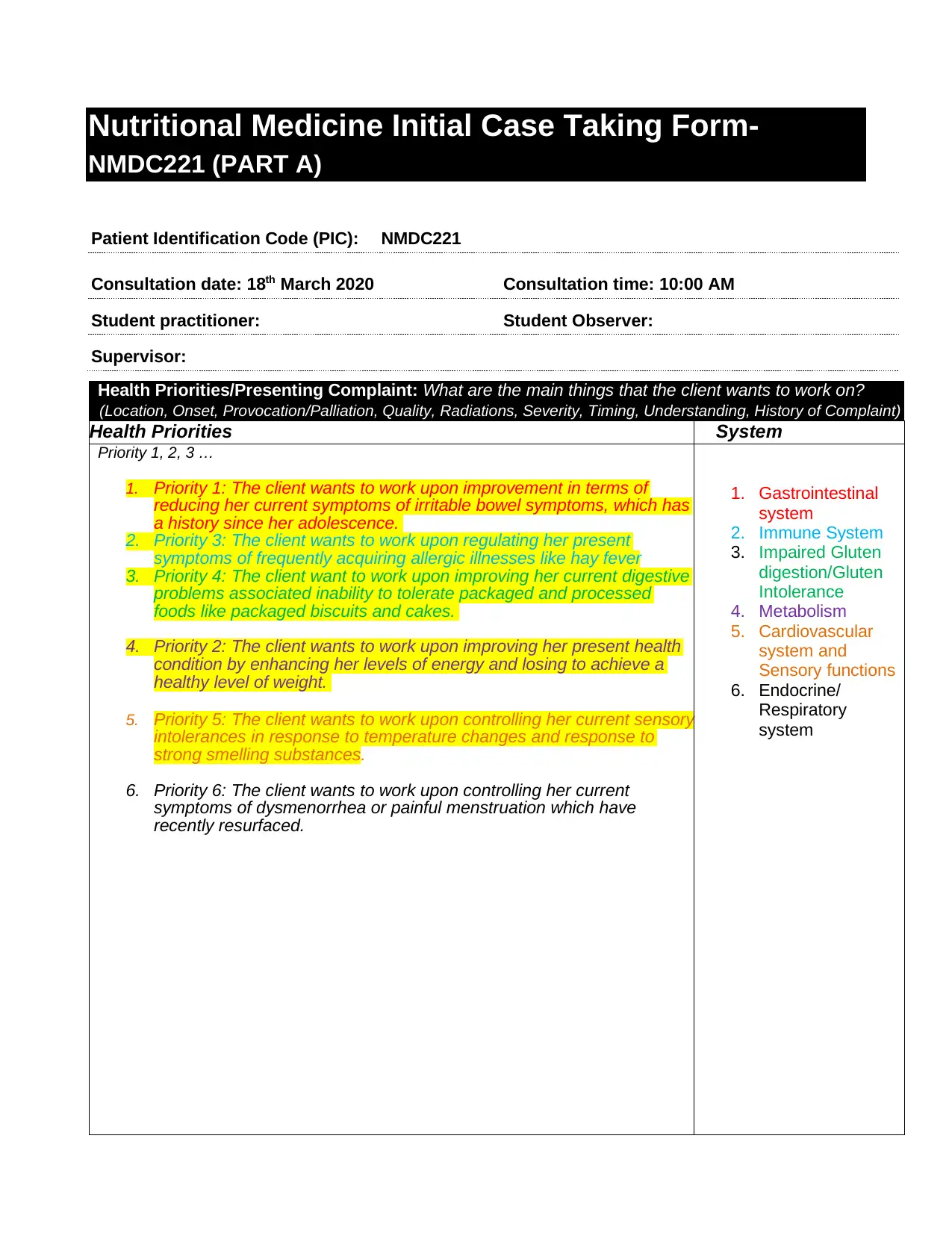
Patient Identification Code (PIC): NMDC221
Consultation date: 18th March 2020 Consultation time: 10:00 AM
Student practitioner: Student Observer:
Supervisor:
Health Priorities/Presenting Complaint: What are the main things that the client wants to work on?
(Location, Onset, Provocation/Palliation, Quality, Radiations, Severity, Timing, Understanding, History of Complaint)
Health Priorities System
Priority 1, 2, 3 …
1. Priority 1: The client wants to work upon improvement in terms of
reducing her current symptoms of irritable bowel symptoms, which has
a history since her adolescence.
2. Priority 3: The client wants to work upon regulating her present
symptoms of frequently acquiring allergic illnesses like hay fever
3. Priority 4: The client want to work upon improving her current digestive
problems associated inability to tolerate packaged and processed
foods like packaged biscuits and cakes.
4. Priority 2: The client wants to work upon improving her present health
condition by enhancing her levels of energy and losing to achieve a
healthy level of weight.
5. Priority 5: The client wants to work upon controlling her current sensory
intolerances in response to temperature changes and response to
strong smelling substances.
6. Priority 6: The client wants to work upon controlling her current
symptoms of dysmenorrhea or painful menstruation which have
recently resurfaced.
1. Gastrointestinal
system
2. Immune System
3. Impaired Gluten
digestion/Gluten
Intolerance
4. Metabolism
5. Cardiovascular
system and
Sensory functions
6. Endocrine/
Respiratory
system
Nutritional Medicine Initial Case Taking Form-
NMDC221 (PART A)
Consultation date: 18th March 2020 Consultation time: 10:00 AM
Student practitioner: Student Observer:
Supervisor:
Health Priorities/Presenting Complaint: What are the main things that the client wants to work on?
(Location, Onset, Provocation/Palliation, Quality, Radiations, Severity, Timing, Understanding, History of Complaint)
Health Priorities System
Priority 1, 2, 3 …
1. Priority 1: The client wants to work upon improvement in terms of
reducing her current symptoms of irritable bowel symptoms, which has
a history since her adolescence.
2. Priority 3: The client wants to work upon regulating her present
symptoms of frequently acquiring allergic illnesses like hay fever
3. Priority 4: The client want to work upon improving her current digestive
problems associated inability to tolerate packaged and processed
foods like packaged biscuits and cakes.
4. Priority 2: The client wants to work upon improving her present health
condition by enhancing her levels of energy and losing to achieve a
healthy level of weight.
5. Priority 5: The client wants to work upon controlling her current sensory
intolerances in response to temperature changes and response to
strong smelling substances.
6. Priority 6: The client wants to work upon controlling her current
symptoms of dysmenorrhea or painful menstruation which have
recently resurfaced.
1. Gastrointestinal
system
2. Immune System
3. Impaired Gluten
digestion/Gluten
Intolerance
4. Metabolism
5. Cardiovascular
system and
Sensory functions
6. Endocrine/
Respiratory
system
Nutritional Medicine Initial Case Taking Form-
NMDC221 (PART A)
Paraphrase This Document
Need a fresh take? Get an instant paraphrase of this document with our AI Paraphraser
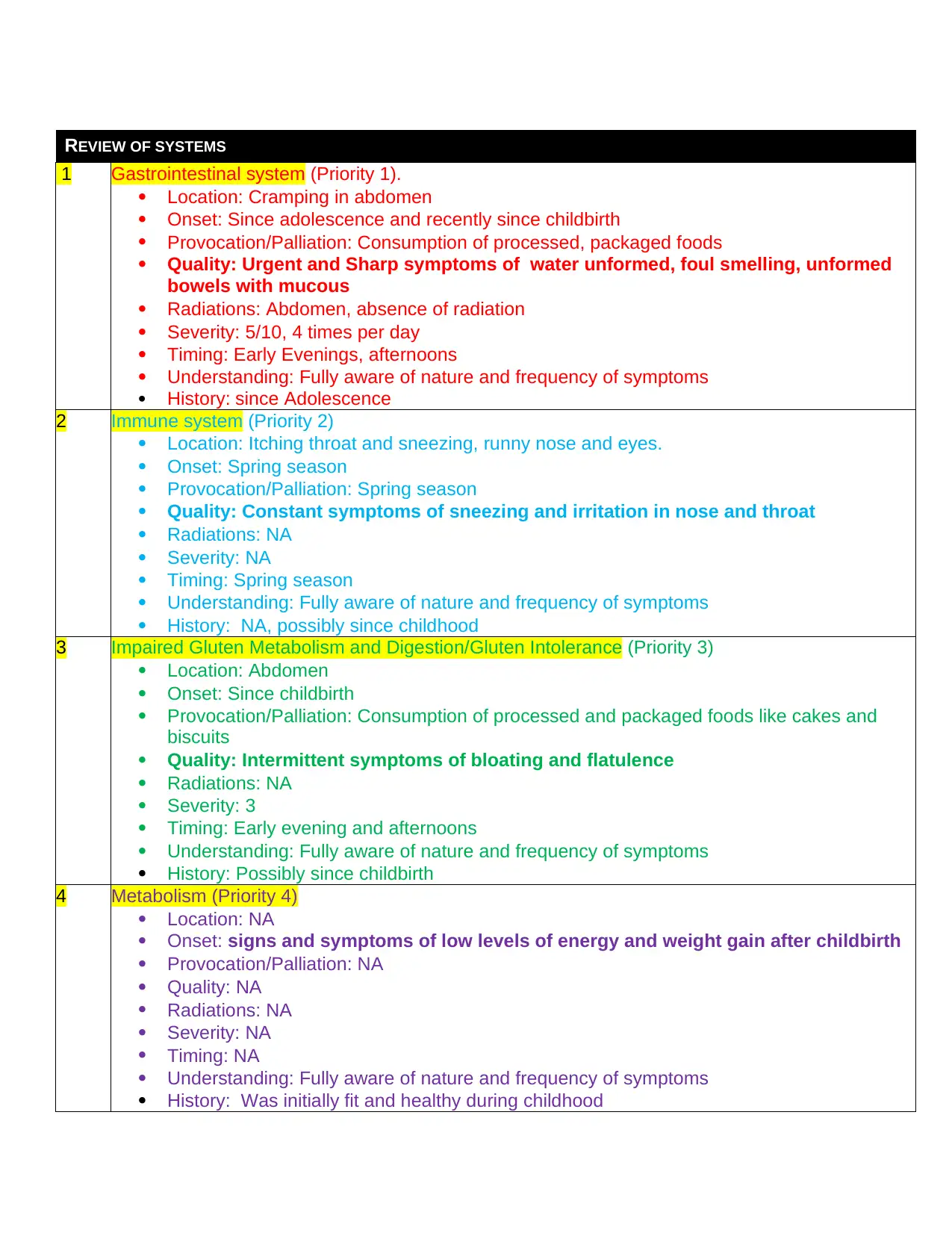
REVIEW OF SYSTEMS
1 Gastrointestinal system (Priority 1).
Location: Cramping in abdomen
Onset: Since adolescence and recently since childbirth
Provocation/Palliation: Consumption of processed, packaged foods
Quality: Urgent and Sharp symptoms of water unformed, foul smelling, unformed
bowels with mucous
Radiations: Abdomen, absence of radiation
Severity: 5/10, 4 times per day
Timing: Early Evenings, afternoons
Understanding: Fully aware of nature and frequency of symptoms
History: since Adolescence
2 Immune system (Priority 2)
Location: Itching throat and sneezing, runny nose and eyes.
Onset: Spring season
Provocation/Palliation: Spring season
Quality: Constant symptoms of sneezing and irritation in nose and throat
Radiations: NA
Severity: NA
Timing: Spring season
Understanding: Fully aware of nature and frequency of symptoms
History: NA, possibly since childhood
3 Impaired Gluten Metabolism and Digestion/Gluten Intolerance (Priority 3)
Location: Abdomen
Onset: Since childbirth
Provocation/Palliation: Consumption of processed and packaged foods like cakes and
biscuits
Quality: Intermittent symptoms of bloating and flatulence
Radiations: NA
Severity: 3
Timing: Early evening and afternoons
Understanding: Fully aware of nature and frequency of symptoms
History: Possibly since childbirth
4 Metabolism (Priority 4)
Location: NA
Onset: signs and symptoms of low levels of energy and weight gain after childbirth
Provocation/Palliation: NA
Quality: NA
Radiations: NA
Severity: NA
Timing: NA
Understanding: Fully aware of nature and frequency of symptoms
History: Was initially fit and healthy during childhood
1 Gastrointestinal system (Priority 1).
Location: Cramping in abdomen
Onset: Since adolescence and recently since childbirth
Provocation/Palliation: Consumption of processed, packaged foods
Quality: Urgent and Sharp symptoms of water unformed, foul smelling, unformed
bowels with mucous
Radiations: Abdomen, absence of radiation
Severity: 5/10, 4 times per day
Timing: Early Evenings, afternoons
Understanding: Fully aware of nature and frequency of symptoms
History: since Adolescence
2 Immune system (Priority 2)
Location: Itching throat and sneezing, runny nose and eyes.
Onset: Spring season
Provocation/Palliation: Spring season
Quality: Constant symptoms of sneezing and irritation in nose and throat
Radiations: NA
Severity: NA
Timing: Spring season
Understanding: Fully aware of nature and frequency of symptoms
History: NA, possibly since childhood
3 Impaired Gluten Metabolism and Digestion/Gluten Intolerance (Priority 3)
Location: Abdomen
Onset: Since childbirth
Provocation/Palliation: Consumption of processed and packaged foods like cakes and
biscuits
Quality: Intermittent symptoms of bloating and flatulence
Radiations: NA
Severity: 3
Timing: Early evening and afternoons
Understanding: Fully aware of nature and frequency of symptoms
History: Possibly since childbirth
4 Metabolism (Priority 4)
Location: NA
Onset: signs and symptoms of low levels of energy and weight gain after childbirth
Provocation/Palliation: NA
Quality: NA
Radiations: NA
Severity: NA
Timing: NA
Understanding: Fully aware of nature and frequency of symptoms
History: Was initially fit and healthy during childhood
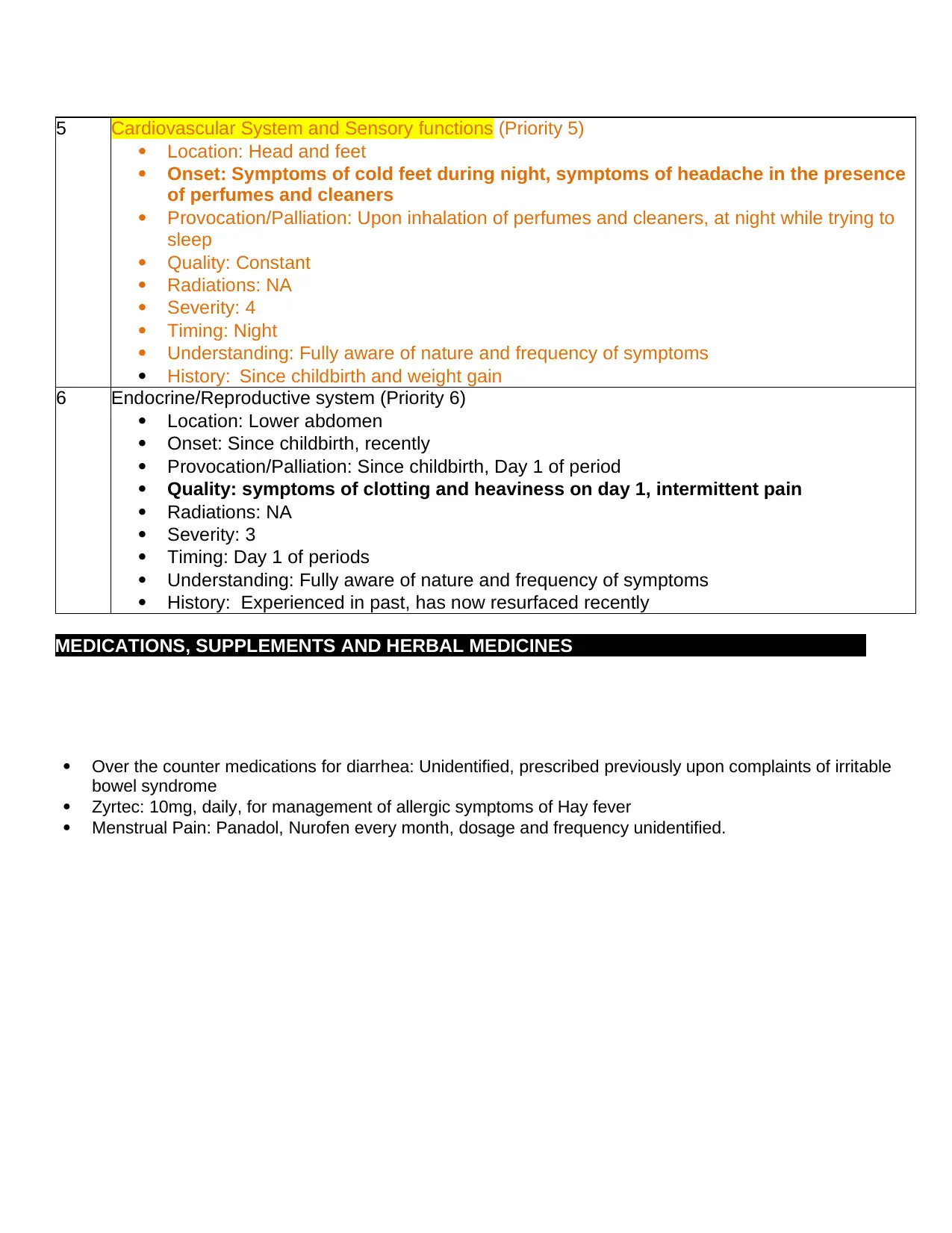
5 Cardiovascular System and Sensory functions (Priority 5)
Location: Head and feet
Onset: Symptoms of cold feet during night, symptoms of headache in the presence
of perfumes and cleaners
Provocation/Palliation: Upon inhalation of perfumes and cleaners, at night while trying to
sleep
Quality: Constant
Radiations: NA
Severity: 4
Timing: Night
Understanding: Fully aware of nature and frequency of symptoms
History: Since childbirth and weight gain
6 Endocrine/Reproductive system (Priority 6)
Location: Lower abdomen
Onset: Since childbirth, recently
Provocation/Palliation: Since childbirth, Day 1 of period
Quality: symptoms of clotting and heaviness on day 1, intermittent pain
Radiations: NA
Severity: 3
Timing: Day 1 of periods
Understanding: Fully aware of nature and frequency of symptoms
History: Experienced in past, has now resurfaced recently
MEDICATIONS, SUPPLEMENTS AND HERBAL MEDICINES
Over the counter medications for diarrhea: Unidentified, prescribed previously upon complaints of irritable
bowel syndrome
Zyrtec: 10mg, daily, for management of allergic symptoms of Hay fever
Menstrual Pain: Panadol, Nurofen every month, dosage and frequency unidentified.
Location: Head and feet
Onset: Symptoms of cold feet during night, symptoms of headache in the presence
of perfumes and cleaners
Provocation/Palliation: Upon inhalation of perfumes and cleaners, at night while trying to
sleep
Quality: Constant
Radiations: NA
Severity: 4
Timing: Night
Understanding: Fully aware of nature and frequency of symptoms
History: Since childbirth and weight gain
6 Endocrine/Reproductive system (Priority 6)
Location: Lower abdomen
Onset: Since childbirth, recently
Provocation/Palliation: Since childbirth, Day 1 of period
Quality: symptoms of clotting and heaviness on day 1, intermittent pain
Radiations: NA
Severity: 3
Timing: Day 1 of periods
Understanding: Fully aware of nature and frequency of symptoms
History: Experienced in past, has now resurfaced recently
MEDICATIONS, SUPPLEMENTS AND HERBAL MEDICINES
Over the counter medications for diarrhea: Unidentified, prescribed previously upon complaints of irritable
bowel syndrome
Zyrtec: 10mg, daily, for management of allergic symptoms of Hay fever
Menstrual Pain: Panadol, Nurofen every month, dosage and frequency unidentified.
⊘ This is a preview!⊘
Do you want full access?
Subscribe today to unlock all pages.

Trusted by 1+ million students worldwide
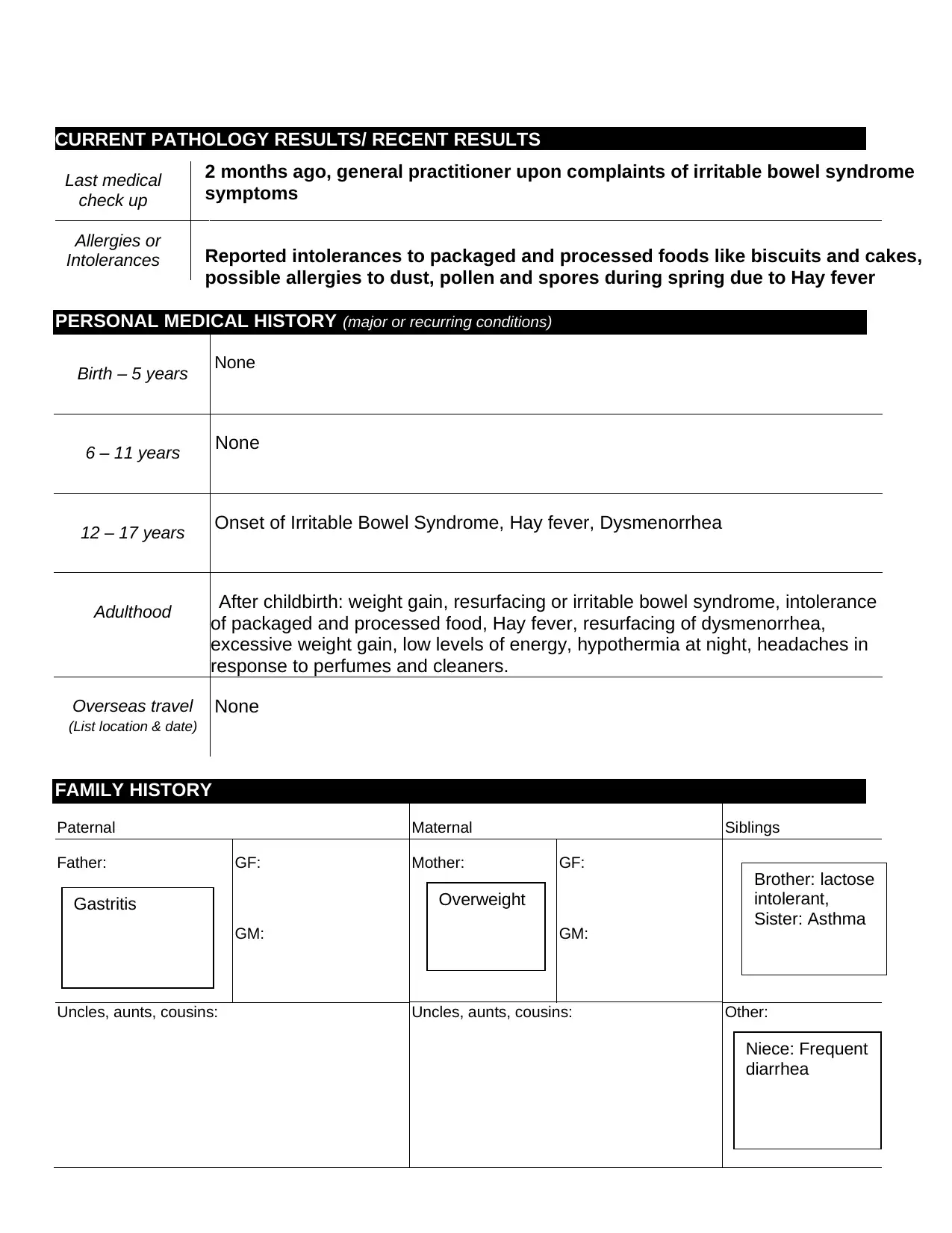
CURRENT PATHOLOGY RESULTS/ RECENT RESULTS
2 months ago, general practitioner upon complaints of irritable bowel syndrome
symptoms
Reported intolerances to packaged and processed foods like biscuits and cakes,
possible allergies to dust, pollen and spores during spring due to Hay fever
PERSONAL MEDICAL HISTORY (major or recurring conditions)
Birth – 5 years None
6 – 11 years None
12 – 17 years Onset of Irritable Bowel Syndrome, Hay fever, Dysmenorrhea
Adulthood After childbirth: weight gain, resurfacing or irritable bowel syndrome, intolerance
of packaged and processed food, Hay fever, resurfacing of dysmenorrhea,
excessive weight gain, low levels of energy, hypothermia at night, headaches in
response to perfumes and cleaners.
Overseas travel
(List location & date)
None
Last medical
check up
Allergies or
Intolerances
Paternal Siblings
Father: GF: GF:
GM: GM:
Uncles, aunts, cousins: Other:Uncles, aunts, cousins:
Mother:
Maternal
FAMILY HISTORY
Brother: lactose
intolerant,
Sister: Asthma
Niece: Frequent
diarrhea
OverweightGastritis
2 months ago, general practitioner upon complaints of irritable bowel syndrome
symptoms
Reported intolerances to packaged and processed foods like biscuits and cakes,
possible allergies to dust, pollen and spores during spring due to Hay fever
PERSONAL MEDICAL HISTORY (major or recurring conditions)
Birth – 5 years None
6 – 11 years None
12 – 17 years Onset of Irritable Bowel Syndrome, Hay fever, Dysmenorrhea
Adulthood After childbirth: weight gain, resurfacing or irritable bowel syndrome, intolerance
of packaged and processed food, Hay fever, resurfacing of dysmenorrhea,
excessive weight gain, low levels of energy, hypothermia at night, headaches in
response to perfumes and cleaners.
Overseas travel
(List location & date)
None
Last medical
check up
Allergies or
Intolerances
Paternal Siblings
Father: GF: GF:
GM: GM:
Uncles, aunts, cousins: Other:Uncles, aunts, cousins:
Mother:
Maternal
FAMILY HISTORY
Brother: lactose
intolerant,
Sister: Asthma
Niece: Frequent
diarrhea
OverweightGastritis
Paraphrase This Document
Need a fresh take? Get an instant paraphrase of this document with our AI Paraphraser
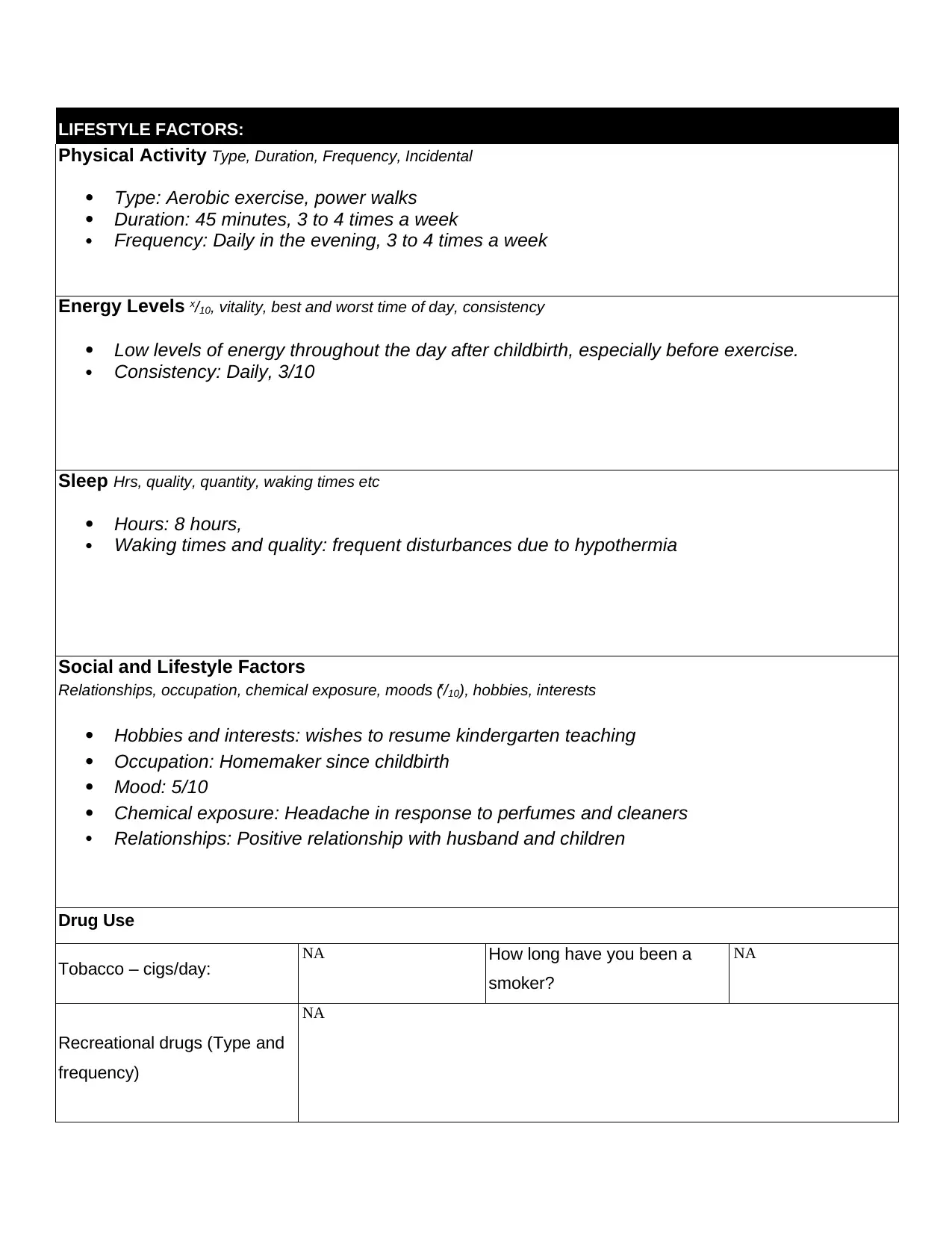
LIFESTYLE FACTORS:
Physical Activity Type, Duration, Frequency, Incidental
Type: Aerobic exercise, power walks
Duration: 45 minutes, 3 to 4 times a week
Frequency: Daily in the evening, 3 to 4 times a week
Energy Levels x/10, vitality, best and worst time of day, consistency
Low levels of energy throughout the day after childbirth, especially before exercise.
Consistency: Daily, 3/10
Sleep Hrs, quality, quantity, waking times etc
Hours: 8 hours,
Waking times and quality: frequent disturbances due to hypothermia
Social and Lifestyle Factors
Relationships, occupation, chemical exposure, moods (x/10), hobbies, interests
Hobbies and interests: wishes to resume kindergarten teaching
Occupation: Homemaker since childbirth
Mood: 5/10
Chemical exposure: Headache in response to perfumes and cleaners
Relationships: Positive relationship with husband and children
Drug Use
Tobacco – cigs/day: NA How long have you been a
smoker?
NA
Recreational drugs (Type and
frequency)
NA
Physical Activity Type, Duration, Frequency, Incidental
Type: Aerobic exercise, power walks
Duration: 45 minutes, 3 to 4 times a week
Frequency: Daily in the evening, 3 to 4 times a week
Energy Levels x/10, vitality, best and worst time of day, consistency
Low levels of energy throughout the day after childbirth, especially before exercise.
Consistency: Daily, 3/10
Sleep Hrs, quality, quantity, waking times etc
Hours: 8 hours,
Waking times and quality: frequent disturbances due to hypothermia
Social and Lifestyle Factors
Relationships, occupation, chemical exposure, moods (x/10), hobbies, interests
Hobbies and interests: wishes to resume kindergarten teaching
Occupation: Homemaker since childbirth
Mood: 5/10
Chemical exposure: Headache in response to perfumes and cleaners
Relationships: Positive relationship with husband and children
Drug Use
Tobacco – cigs/day: NA How long have you been a
smoker?
NA
Recreational drugs (Type and
frequency)
NA
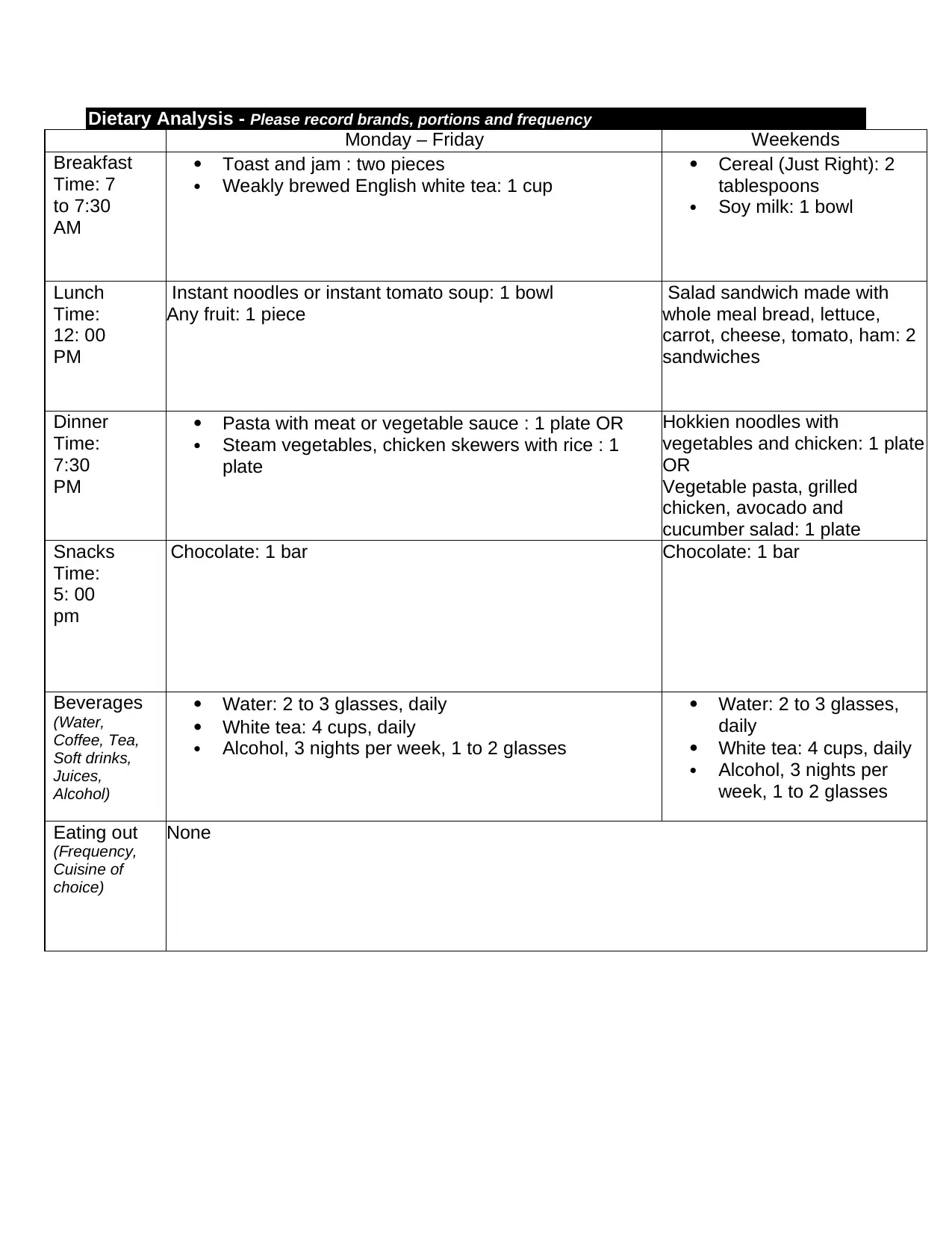
Monday – Friday Weekends
Breakfast
Time: 7
to 7:30
AM
Toast and jam : two pieces
Weakly brewed English white tea: 1 cup
Cereal (Just Right): 2
tablespoons
Soy milk: 1 bowl
Lunch
Time:
12: 00
PM
Instant noodles or instant tomato soup: 1 bowl
Any fruit: 1 piece
Salad sandwich made with
whole meal bread, lettuce,
carrot, cheese, tomato, ham: 2
sandwiches
Dinner
Time:
7:30
PM
Pasta with meat or vegetable sauce : 1 plate OR
Steam vegetables, chicken skewers with rice : 1
plate
Hokkien noodles with
vegetables and chicken: 1 plate
OR
Vegetable pasta, grilled
chicken, avocado and
cucumber salad: 1 plate
Snacks
Time:
5: 00
pm
Chocolate: 1 bar Chocolate: 1 bar
Beverages
(Water,
Coffee, Tea,
Soft drinks,
Juices,
Alcohol)
Water: 2 to 3 glasses, daily
White tea: 4 cups, daily
Alcohol, 3 nights per week, 1 to 2 glasses
Water: 2 to 3 glasses,
daily
White tea: 4 cups, daily
Alcohol, 3 nights per
week, 1 to 2 glasses
Eating out
(Frequency,
Cuisine of
choice)
None
Dietary Analysis - Please record brands, portions and frequency
Breakfast
Time: 7
to 7:30
AM
Toast and jam : two pieces
Weakly brewed English white tea: 1 cup
Cereal (Just Right): 2
tablespoons
Soy milk: 1 bowl
Lunch
Time:
12: 00
PM
Instant noodles or instant tomato soup: 1 bowl
Any fruit: 1 piece
Salad sandwich made with
whole meal bread, lettuce,
carrot, cheese, tomato, ham: 2
sandwiches
Dinner
Time:
7:30
PM
Pasta with meat or vegetable sauce : 1 plate OR
Steam vegetables, chicken skewers with rice : 1
plate
Hokkien noodles with
vegetables and chicken: 1 plate
OR
Vegetable pasta, grilled
chicken, avocado and
cucumber salad: 1 plate
Snacks
Time:
5: 00
pm
Chocolate: 1 bar Chocolate: 1 bar
Beverages
(Water,
Coffee, Tea,
Soft drinks,
Juices,
Alcohol)
Water: 2 to 3 glasses, daily
White tea: 4 cups, daily
Alcohol, 3 nights per week, 1 to 2 glasses
Water: 2 to 3 glasses,
daily
White tea: 4 cups, daily
Alcohol, 3 nights per
week, 1 to 2 glasses
Eating out
(Frequency,
Cuisine of
choice)
None
Dietary Analysis - Please record brands, portions and frequency
⊘ This is a preview!⊘
Do you want full access?
Subscribe today to unlock all pages.

Trusted by 1+ million students worldwide
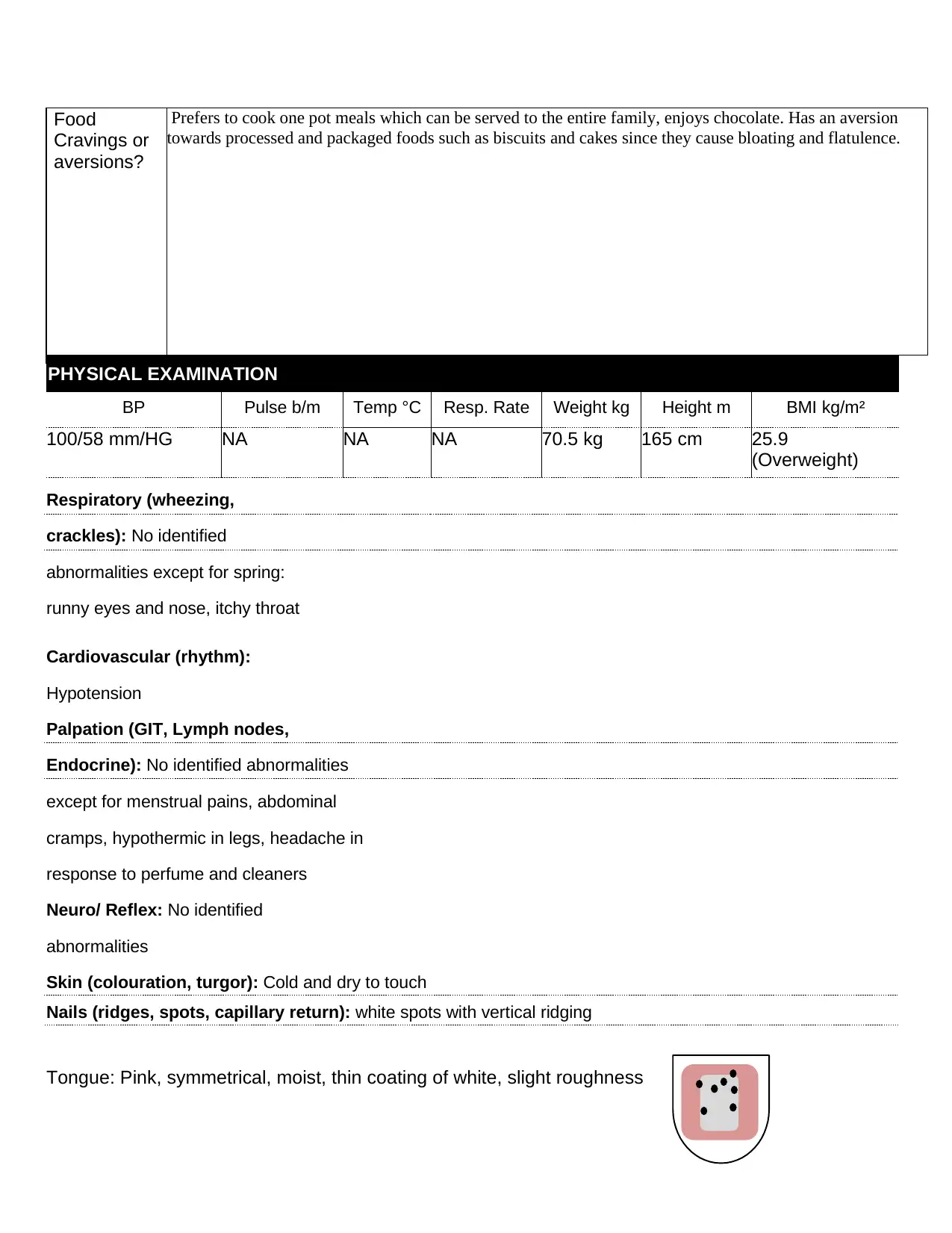
Food
Cravings or
aversions?
Prefers to cook one pot meals which can be served to the entire family, enjoys chocolate. Has an aversion
towards processed and packaged foods such as biscuits and cakes since they cause bloating and flatulence.
PHYSICAL EXAMINATION
BP Pulse b/m Temp °C Resp. Rate Weight kg Height m BMI kg/m²
100/58 mm/HG NA NA NA 70.5 kg 165 cm 25.9
(Overweight)
Respiratory (wheezing,
crackles): No identified
abnormalities except for spring:
runny eyes and nose, itchy throat
Cardiovascular (rhythm):
Hypotension
Palpation (GIT, Lymph nodes,
Endocrine): No identified abnormalities
except for menstrual pains, abdominal
cramps, hypothermic in legs, headache in
response to perfume and cleaners
Neuro/ Reflex: No identified
abnormalities
Skin (colouration, turgor): Cold and dry to touch
Nails (ridges, spots, capillary return): white spots with vertical ridging
Tongue: Pink, symmetrical, moist, thin coating of white, slight roughness
Cravings or
aversions?
Prefers to cook one pot meals which can be served to the entire family, enjoys chocolate. Has an aversion
towards processed and packaged foods such as biscuits and cakes since they cause bloating and flatulence.
PHYSICAL EXAMINATION
BP Pulse b/m Temp °C Resp. Rate Weight kg Height m BMI kg/m²
100/58 mm/HG NA NA NA 70.5 kg 165 cm 25.9
(Overweight)
Respiratory (wheezing,
crackles): No identified
abnormalities except for spring:
runny eyes and nose, itchy throat
Cardiovascular (rhythm):
Hypotension
Palpation (GIT, Lymph nodes,
Endocrine): No identified abnormalities
except for menstrual pains, abdominal
cramps, hypothermic in legs, headache in
response to perfume and cleaners
Neuro/ Reflex: No identified
abnormalities
Skin (colouration, turgor): Cold and dry to touch
Nails (ridges, spots, capillary return): white spots with vertical ridging
Tongue: Pink, symmetrical, moist, thin coating of white, slight roughness
Paraphrase This Document
Need a fresh take? Get an instant paraphrase of this document with our AI Paraphraser
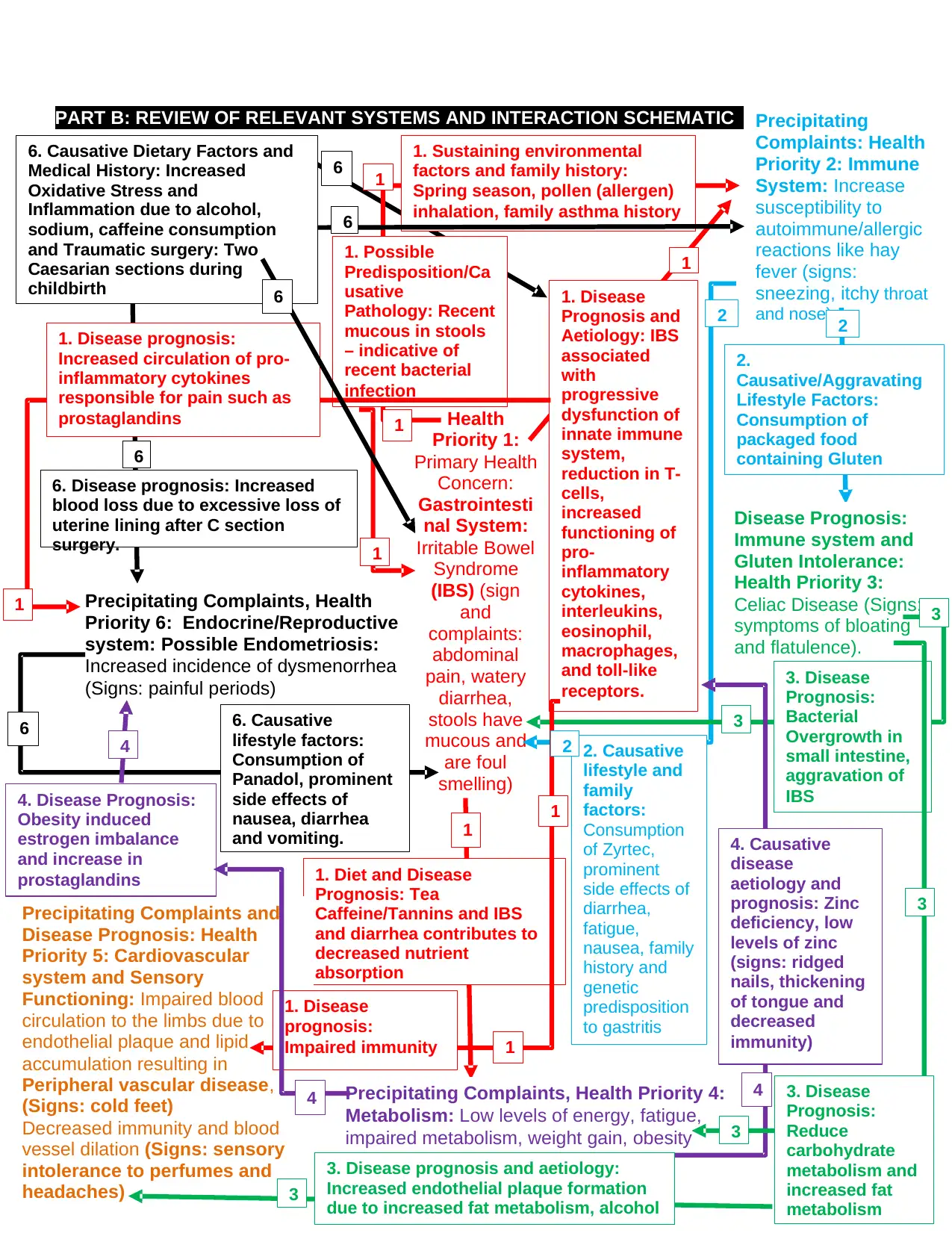
PART B: REVIEW OF RELEVANT SYSTEMS AND INTERACTION SCHEMATIC
Health
Priority 1:
Primary Health
Concern:
Gastrointesti
nal System:
Irritable Bowel
Syndrome
(IBS) (sign
and
complaints:
abdominal
pain, watery
diarrhea,
stools have
mucous and
are foul
smelling)
1. Disease
Prognosis and
Aetiology: IBS
associated
with
progressive
dysfunction of
innate immune
system,
reduction in T-
cells,
increased
functioning of
pro-
inflammatory
cytokines,
interleukins,
eosinophil,
macrophages,
and toll-like
receptors.
1. Possible
Predisposition/Ca
usative
Pathology: Recent
mucous in stools
– indicative of
recent bacterial
infection
Precipitating
Complaints: Health
Priority 2: Immune
System: Increase
susceptibility to
autoimmune/allergic
reactions like hay
fever (signs:
sneezing, itchy throat
and nose).
2. Causative
lifestyle and
family
factors:
Consumption
of Zyrtec,
prominent
side effects of
diarrhea,
fatigue,
nausea, family
history and
genetic
predisposition
to gastritis
Disease Prognosis:
Immune system and
Gluten Intolerance:
Health Priority 3:
Celiac Disease (Signs:
symptoms of bloating
and flatulence).
2.
Causative/Aggravating
Lifestyle Factors:
Consumption of
packaged food
containing Gluten
3. Disease
Prognosis:
Bacterial
Overgrowth in
small intestine,
aggravation of
IBS
1. Sustaining environmental
factors and family history:
Spring season, pollen (allergen)
inhalation, family asthma history
Precipitating Complaints, Health Priority 4:
Metabolism: Low levels of energy, fatigue,
impaired metabolism, weight gain, obesity
Precipitating Complaints, Health
Priority 6: Endocrine/Reproductive
system: Possible Endometriosis:
Increased incidence of dysmenorrhea
(Signs: painful periods)
4. Causative
disease
aetiology and
prognosis: Zinc
deficiency, low
levels of zinc
(signs: ridged
nails, thickening
of tongue and
decreased
immunity)
6. Causative
lifestyle factors:
Consumption of
Panadol, prominent
side effects of
nausea, diarrhea
and vomiting.
1. Diet and Disease
Prognosis: Tea
Caffeine/Tannins and IBS
and diarrhea contributes to
decreased nutrient
absorption
3. Disease
Prognosis:
Reduce
carbohydrate
metabolism and
increased fat
metabolism
Precipitating Complaints and
Disease Prognosis: Health
Priority 5: Cardiovascular
system and Sensory
Functioning: Impaired blood
circulation to the limbs due to
endothelial plaque and lipid
accumulation resulting in
Peripheral vascular disease,
(Signs: cold feet)
Decreased immunity and blood
vessel dilation (Signs: sensory
intolerance to perfumes and
headaches)
3. Disease prognosis and aetiology:
Increased endothelial plaque formation
due to increased fat metabolism, alcohol
1. Disease
prognosis:
Impaired immunity
1. Disease prognosis:
Increased circulation of pro-
inflammatory cytokines
responsible for pain such as
prostaglandins
6. Causative Dietary Factors and
Medical History: Increased
Oxidative Stress and
Inflammation due to alcohol,
sodium, caffeine consumption
and Traumatic surgery: Two
Caesarian sections during
childbirth
6. Disease prognosis: Increased
blood loss due to excessive loss of
uterine lining after C section
surgery.
4. Disease Prognosis:
Obesity induced
estrogen imbalance
and increase in
prostaglandins
1
1
1
1
1
1
1
1
2
2
2
3
3
3
3
3
4
4
4
6
6
6
6
6
Health
Priority 1:
Primary Health
Concern:
Gastrointesti
nal System:
Irritable Bowel
Syndrome
(IBS) (sign
and
complaints:
abdominal
pain, watery
diarrhea,
stools have
mucous and
are foul
smelling)
1. Disease
Prognosis and
Aetiology: IBS
associated
with
progressive
dysfunction of
innate immune
system,
reduction in T-
cells,
increased
functioning of
pro-
inflammatory
cytokines,
interleukins,
eosinophil,
macrophages,
and toll-like
receptors.
1. Possible
Predisposition/Ca
usative
Pathology: Recent
mucous in stools
– indicative of
recent bacterial
infection
Precipitating
Complaints: Health
Priority 2: Immune
System: Increase
susceptibility to
autoimmune/allergic
reactions like hay
fever (signs:
sneezing, itchy throat
and nose).
2. Causative
lifestyle and
family
factors:
Consumption
of Zyrtec,
prominent
side effects of
diarrhea,
fatigue,
nausea, family
history and
genetic
predisposition
to gastritis
Disease Prognosis:
Immune system and
Gluten Intolerance:
Health Priority 3:
Celiac Disease (Signs:
symptoms of bloating
and flatulence).
2.
Causative/Aggravating
Lifestyle Factors:
Consumption of
packaged food
containing Gluten
3. Disease
Prognosis:
Bacterial
Overgrowth in
small intestine,
aggravation of
IBS
1. Sustaining environmental
factors and family history:
Spring season, pollen (allergen)
inhalation, family asthma history
Precipitating Complaints, Health Priority 4:
Metabolism: Low levels of energy, fatigue,
impaired metabolism, weight gain, obesity
Precipitating Complaints, Health
Priority 6: Endocrine/Reproductive
system: Possible Endometriosis:
Increased incidence of dysmenorrhea
(Signs: painful periods)
4. Causative
disease
aetiology and
prognosis: Zinc
deficiency, low
levels of zinc
(signs: ridged
nails, thickening
of tongue and
decreased
immunity)
6. Causative
lifestyle factors:
Consumption of
Panadol, prominent
side effects of
nausea, diarrhea
and vomiting.
1. Diet and Disease
Prognosis: Tea
Caffeine/Tannins and IBS
and diarrhea contributes to
decreased nutrient
absorption
3. Disease
Prognosis:
Reduce
carbohydrate
metabolism and
increased fat
metabolism
Precipitating Complaints and
Disease Prognosis: Health
Priority 5: Cardiovascular
system and Sensory
Functioning: Impaired blood
circulation to the limbs due to
endothelial plaque and lipid
accumulation resulting in
Peripheral vascular disease,
(Signs: cold feet)
Decreased immunity and blood
vessel dilation (Signs: sensory
intolerance to perfumes and
headaches)
3. Disease prognosis and aetiology:
Increased endothelial plaque formation
due to increased fat metabolism, alcohol
1. Disease
prognosis:
Impaired immunity
1. Disease prognosis:
Increased circulation of pro-
inflammatory cytokines
responsible for pain such as
prostaglandins
6. Causative Dietary Factors and
Medical History: Increased
Oxidative Stress and
Inflammation due to alcohol,
sodium, caffeine consumption
and Traumatic surgery: Two
Caesarian sections during
childbirth
6. Disease prognosis: Increased
blood loss due to excessive loss of
uterine lining after C section
surgery.
4. Disease Prognosis:
Obesity induced
estrogen imbalance
and increase in
prostaglandins
1
1
1
1
1
1
1
1
2
2
2
3
3
3
3
3
4
4
4
6
6
6
6
6
1 out of 8
Your All-in-One AI-Powered Toolkit for Academic Success.
+13062052269
info@desklib.com
Available 24*7 on WhatsApp / Email
![[object Object]](/_next/static/media/star-bottom.7253800d.svg)
Unlock your academic potential
Copyright © 2020–2025 A2Z Services. All Rights Reserved. Developed and managed by ZUCOL.
